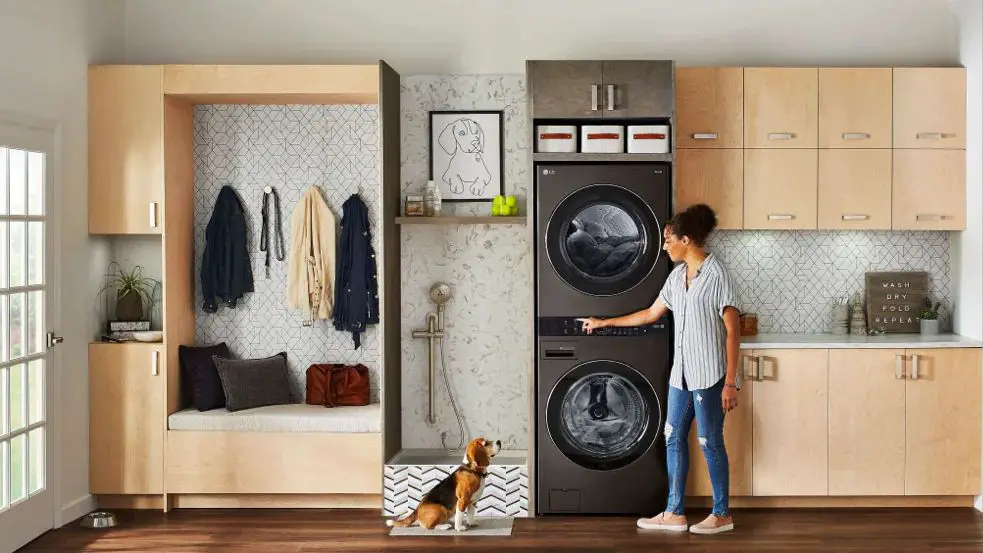Stackable washer and dryer units are a convenient space-saving option for many households. These units allow you to install a washer and dryer one above the other in a vertical configuration. This frees up floor space compared to having separate side-by-side or over/under units.
One of the key considerations with stackable units is their electrical requirements. Specifically, whether they can operate on a standard 110V household circuit. Or if they require a 220V connection instead.
The voltage a particular appliance needs depends on its power consumption. Smaller, more energy efficient models can often run on 110V. While larger, more powerful units require 220V to deliver enough electricity.
In this article, we’ll look at the electrical requirements for stackable washer dryer units. And discuss the pros and cons of 110V versus 220V models.
Page Contents
Do All Stackable Washers and Dryers Run on 110V?
Not necessarily. Some stackable washer and dryer sets are designed to run on standard 110V household current. But larger units require a 220V hookup instead.
There are a few factors that determine whether a particular stackable set can operate on 110V:
– **Washing/drying capacity** – Smaller units with load capacities of less than 3 cubic feet can often run on 110V. Larger units require 220V to power the higher wattage motors and controls.
– **Energy efficiency** – More efficient front-load washer and condensing dryer models use less electricity. This allows them to run on 110V in many cases. While standard top-load washers and vented dryers need 220V to deliver enough power.
– **Motor size** – The size of the washer motor also impacts voltage needs. Smaller motors on compact units can operate on 110V. But larger washers need beefier motors requiring 220V.
So in summary, smaller capacity, energy efficient stackable units may be able to run on 110V. But larger units will usually require 220V connections. Always check the manufacturer’s electrical specs before installation.
Pros and Cons of 110V vs 220V for Stackable Units
There are some important tradeoffs to consider with 110V versus 220V stackable washer and dryer sets:
**110V Pros**
– Don’t need special 220V wiring run. Can use existing household 110V circuits.
– Often sufficient for compact units with smaller load capacities.
– Units have lower peak power consumption on 110V.
**110V Cons**
– Not suitable for larger washers and dryers. Limits capacity and performance.
– Motors and controls can strain on 110V circuit if close to max load.
– Longer drying times required on 110V.
**220V Pros**
– Allows for larger capacity units and more powerful motors.
– Faster drying times achievable.
-Dedicated circuit provides plenty of power for simultaneous washing and drying.
**220V Cons**
– Requires installing new 220V wiring and outlet. Added cost for electrical work.
– Higher energy consumption than equivalent 110V models.
– Safety issues if 220V wiring not properly installed.
As you can see there are good reasons for choosing either voltage based on your needs and existing electrical setup. 110V is simpler for smaller units but 220V enables larger capacities.
Typical Electrical Specifications
To give you a better idea of typical electrical requirements, here are some example specs for different stackable washer and dryer models and configurations:
Compact Stackable Unit
**Washer**
– Capacity: 2.2 cu ft
– Max power: 550 watts
– Voltage: 110V
**Dryer**
– Capacity: 3.8 cu ft
– Max power: 1200 watts
– Voltage: 110V
*Runs on standard 110V household circuit*
Mid-Size Stackable Unit
**Washer**
– Capacity: 3.5 cu ft
– Max power: 1100 watts
– Voltage: 110V
**Dryer**
– Capacity: 6.7 cu ft
– Max power: 3400 watts
– Voltage: 220V
*Washer 110V, dryer requires 220V*
Large Stackable Unit
**Washer**
– Capacity: 4.5 cu ft
– Max power: 1500 watts
– Voltage: 220V
**Dryer**
– Capacity: 7.5 cu ft
– Max power: 5500 watts
– Voltage: 220V
*Requires 220V connection*
As you can see, the electrical requirements vary significantly based on capacity and washer/dryer configurations. Always consult the manufacturer specifications for your particular models.
Installation Tips for 110V Stackable Units
If you do have a smaller 110V stackable set, here are some tips to ensure proper installation:
– Use a dedicated 20 amp circuit for the units. This provides enough power cushion for simultaneous washing and drying.
– 12 gauge power wires are recommended for the dedicated circuit. Provides safety margin over standard 14 gauge wires.
– Include at least 6 inch clearance behind units for ventilation.
– Level and secure units properly to prevent vibration and movement issues.
– Install drain pan underneath to catch any water leaks.
– Use a surge protector or UPS system to protect electronics from power spikes.
Following these guidelines helps ensure your 110V stackable set runs safely and efficiently over its lifetime.
Conclusion
The electrical requirements for stackable washer and dryer sets depend on their size and design. Smaller compact units may operate on standard 110V household current. But larger units with bigger motors and higher capacity require 220V connections.
The pros and cons of 110V versus 220V relate to capacity, drying power, installation cost, and energy use. Carefully evaluate your needs and electrical system capabilities when choosing stackable units. And be sure to follow the manufacturer’s voltage specifications for safe and effective operation. With the proper electrical setup, stackable washer dryers can be a convenient laundry solution in limited spaces.
